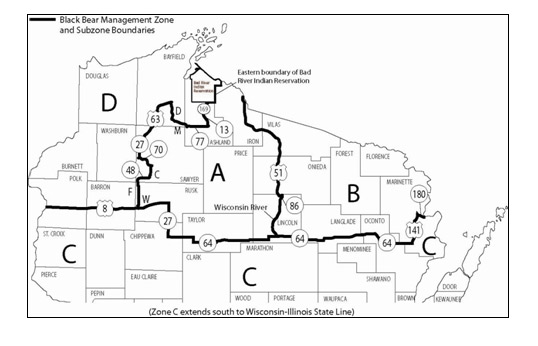Bear Season Forecast 2012
By Kevin Wallenfang, Scott Roepke, and Dan Hirchert
The 2012 Wisconsin bear hunting season promises to provide excellent hunting opportunities for those pursuing one of the state’s most prestigious big-game species. Across the north, bears are abundant! Annually, Wisconsin ranks among the leaders in bear harvest in terms of both numbers and record-book entries. Increased permit levels in 2011 resulted in hunters registering 4,257 bears, the second highest harvest ever recorded in the state following the record kill of 5,133 bears in 2010. In fact, in 2011 Wisconsin harvested more bears than any other state. Zone A led all zones with 1,592 bears harvested. Zones B and D had nearly identical harvests, with 969 and 975 bears harvested, respectively, while zone C was responsible for 715 bears. Overall, hunters were most successful in zones B and D (64% and 66% success rates, respectively) followed by zone A (46%) and zone C (28%). Bayfield, Price, and Sawyer counties were the leading counties in harvest totals. The bear population in southern Wisconsin continues to expand, with hunters harvesting bears as far south as Trempealeau, Monroe, Juneau, Portage, Waupaca, and Outagamie counties. Hunters harvested 3,612 of the bears with a gun, while bowhunters accounted for 552 bears. Hunting bears with bait was the primary hunting method with 2,705 bears harvested with this method, while dog hunters harvested 1,446 bears. Fifty-seven bears were harvested without the aid of bait or dogs.
In 2012, 9,015 permits have been awarded, a slight increase over the 9,005 permits issued last year. This year hunters not utilizing dogs will have the first week of the season to themselves, after which time hunters using dogs will be allowed to pursue bears during the same timeframe with those who do not use dogs (except in Zone C where the use of dogs is not permitted). The last week of the season in zones A, B, and D is reserved for hunting with the aid of dogs only.
Again this year, hunters will be required to submit both a tooth and rib sample to the DNR at the time of registration to aid wildlife managers in estimating the age of harvested bears and in estimating the size of the state’s bear population. These data are essential for managers to properly manage Wisconsin’s bear population; maximizing hunting opportunities while maintaining a robust statewide bear population to ensure future generations of hunters will also have opportunities to bear hunt. All of the materials necessary to submit these samples will be available at the registration station. We would like to thank all of the successful hunters for taking the time to submit these samples as your cooperation will help to ensure the future of bear and bear hunting in Wisconsin.
If you are looking for a place to hunt bears, please visit the WDNR’s website to learn more about public-access lands in Wisconsin. Wisconsin has an abundance of land open to hunting, including State, National, and County Forests, state-owned wildlife areas, and private land enrolled in the Managed Forest Law (MFL) or Voluntary Public Access (VPA) programs. Combined, hunters have access to nearly seven million acres of land throughout Wisconsin!
Detailed information on bear hunting in Wisconsin, including the updated bear hunting regulations, is available on the DNR’s Bear Hunting website. Remember, the deadline to apply for the 2013 bear season is December 10, 2012. You may apply online, by telephone at 1-877-945-4236, at any DNR service center, or at a DNR licensing agent. For more information contact: Scott Roepke – (608) 261-7588.
Bear Season Information
Zones A, B, and D:
September 5 – September 11: With the aid of bait and other legal methods not utilizing dogs.
September 12 – October 2: With the aid of bait, dogs, and other legal methods.
October 3 – October 9: With the aid of dogs only
Zone C:
September 5 – October 9: With the aid of bait or other legal methods not utilizing dogs.

Northern District
By Mike Zeckmeister
The combination of a very mild winter and early spring conditions indeed benefited bears. This should be evident in the upcoming season. We have had several reports of bear litters of 2-4 cubs, even into mid-summer. Farmers were able to get into their fields earlier this year to get a jump start with their planting and this will likely affect when crops are harvested. We did have some spring freezes that appeared to affect soft mast production, at least compared to last year in many parts of the North. One biologist for northeast Wisconsin, noted an abundant blackberry crop in Vilas County reporting “The blackberry canes were LOADED with berries like I’ve never seen before. Conversely, raspberries were hard to find. Blueberries were very spottie, and small fruit.”
How all this plays into bear movements during the bear season will remain to be seen. The level of bear nuisance complaints appear to be high especially in Zones D and A, and this could be an indicator of still high bear numbers in these zones, or that they are having difficulty finding food. Bear complaints in Zone B appear to have tapered off compared to past years when the bear population was too high. If you are fortunate to draw a tag this year, enjoy your time pursuing this truly magnificent big game animal in the northwoods. Advanced scouting and really "sticking it out" will maximize your opportunity. Being flexible is another really good tip. Bears have a habit of changing their movements...it is the key for their survival and hunters often need to adjust to these changes. That is what makes hunting a challenge. Enjoy your time!
Northeast District
By John Huff and Dave Halfmann
The Northeast District has portions of Bear Management Zones B and C. The harvest quota in Zone B was reduced slightly in 2012, but the permit level remains high. In Zone C, the harvest quota was increased slightly. Hunters might experience some competition pressure, particularly on public lands in Zone B. Bear are abundant in Zone B with recent harvests appearing to stabilize or slightly reduce the number of bears. In Zone C, bears are most abundant in the northern part of the zone. They are expanding their range and may be found in areas where bears were absent until the recent past. Preseason scouting for hunting locations is important in both zones.
For hunters using hounds, the Department has a website showing areas where dogs have been lost to wolves. This can be viewed at http://dnr.wi.gov/org/land/er/mammals/wolf/dogdepred.htm. In general hunters using dogs should use caution in most areas of the bear range as wolves are protective of their territories, particularly rendezvous sites, especially to “trespass” by other canids.
The blueberry, cherry, and service berry crop is very poor this year due to frost and dry, hot conditions. Blackberries may have a fair crop although dry conditions are affecting the fruit. Bait sitters may see good activity early in the season. The hazel nut crop appears good but it is too early to determine the success of acorn production.
West Central District
By Wayne Hall
The bear population throughout the west central region continues to grow. Increased sightings reported in the southern/southwestern part of the region continue as bears expand their range into these areas. Based on early reports it appears the percentage of bait stations being hit/visited by bear are similar to last year. Reports of nuisance complaints received by biologist this year vary across the WC district from numerous complaints in Jackson County to a few complaints in Marathon County. People in the southern area where bear range is expanding are becoming more acclimated to seeing bears.
In 2011, there were 2,550 permits available in Zone C. Hunters harvested 715 bear for a 28% success rate. Of these, 357 bear were harvested in the WC region. Most of the WC region’s harvest took place in Chippewa, Clark, Jackson and Marathon counties, but several bear were harvested further south towards Monroe and Juneau Counties.
For 2012, Zone C harvest permits were increased 16% (2970) as we work to manage the expanding population to minimize bear damage and nuisance complaints. While traditional hunting grounds in the northern parts of the region still hold plenty of bear, increased numbers throughout the region offer hunters the opportunity to spread out and perhaps hunt closer to home.
Connect with the Bear Pages on the DNR website at:









